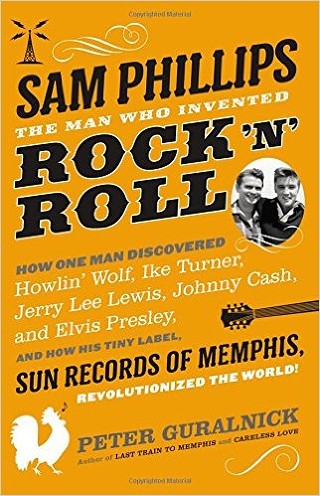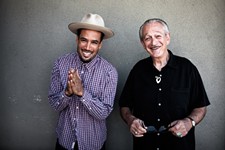Summer Reading: Sam Phillips
Digging into the landmark bio of rock & roll’s colonel
By Tim Stegall, 11:30AM, Fri. Jun. 17, 2016
Our December detailing of Elvis Presley’s early shows in Austin coincided with publication of a definitive biography on the man who discovered him. Sam Phillips: The Man Who Invented Rock & Roll by Peter Guralnick provided deep background on the moment Presley became Johnny Appleseed and transformed music. Missing was analysis of the book itself.
Sam Phillips: The Man Who Invented Rock & Roll by Peter Guralnick Little, Brown & Company, 753 pp., $32
“Mystery Train.” “Blue Suede Shoes.” “Baby Let’s Play House.” “I Walk the Line.” “Whole Lotta Shakin’ Goin’ On.” “Rocket 88.” “Moanin’ at Midnight.” “How Many More Years.”
This cursory list of songs Sam C. Phillips produced at 706 Union Avenue in Memphis, either releasing them himself or leasing to other seminal imprints like Chess Records, reveals that the title to Peter Guralnick’s definitive Phillips biography is no idle boast. The remaining subtitle almost reveals the plot line to last November’s epic tome: “How one man discovered Howlin’ Wolf, Ike Turner, Jerry Lee Lewis, Johnny Cash, and Elvis Presley, and how his tiny label, Sun Records of Memphis, revolutionized the world!”
That barely touches on the achievements of Phillips (1923-2003), much less the breadth, scope, and importance of Sam Phillips: The Man Who Invented Rock & Roll.
Born – as the infinitely oratorial producer once said of his greatest discovery, Presley – “of the soil” outside Florence, Alabama, Phillips found his life’s inspiration via the lives, music, and culture of the black men and women he grew up alongside.
“They found a way to worship,” he says six pages in. “You could hear it. You could feel it. You didn’t have to be inside a building. You could participate in a cotton patch, picking four rows at a time, at 110 degrees! I mean, I saw the inequity.
“But even at 5 or 6 years old I found myself caught up in a type of emotional reaction .... I mean, these were some of the astutest people I’ve ever known, and they were in [most] cases almost totally overlooked, except as a beast of burden. But even at that age, I recognized that ... the backs of these people aren’t broken.
“They [can] find it in their souls to live a life that is not going to take the joy of living away.”
Therein lies the Damascene moment that defines Phillips’ life, driving his business and creative model, and leading to an obsessive documentation of the blues. That and the recording of pilled-up hillbillies’ manic iterations of the blues inside his echo chamber gave rise to rockabilly out of Phillips’ statement that manifested in the discovery and rise of Presley: “If I could find a white man who had the Negro sound and the Negro feel, I could make a billion dollars.”
It also made Phillips, for all intents and purposes, an early Civil Rights warrior, subversively injecting African-American DNA into mainstream American pop culture via the agency of those Southern hep cats to whose music he was applying slapback and urging them to relax and plumb artistic depths they oft-times hardly realized they had themselves. In urging the musicians cramming into Memphis Recording Service’s magic room to “give ol’ Sam one more,” he got future legends to be more themselves than they knew they could be.
Phillips amassed a vast fortune in uncanny investments in both Holiday Inn and various unconventionally formatted radio stations. The latter proved amazingly profitable, his sons eventually running the family empire for their father as he advanced in years. Even then, however, he still thought and acted youthful, being extra careful to maintain an ageless appearance.
Guralnick’s long been America’s finest writer on Southern musical idioms, a reputation staked on his definitive two-volume Presley biography, Last Train to Memphis and Careless Love, published in 1994 and 1999, respectively. In documenting the life of Phillips, who became a friend across the author’s pursuit of the Presley tale, Guralnick’s likely even topped those books. He creates the closest thing to a Sam Phillips memoir, oft-times assuming his subject’s own hillbilly tent-revival preacher cadences – to the point where one might confuse text and the subject’s quotes.
Other legends weave in and out, including B.B. King, Dewey Phillips, and Charlie Rich, who Phillips eternally regretted not helping realize his full potential. When his own life is summed up, Sam Phillips: The Man Who Invented Rock & Roll will stand as Peter Guralnick’s greatest achievement. It’s poetry worthy of a college textbook.
A note to readers: Bold and uncensored, The Austin Chronicle has been Austin’s independent news source for over 40 years, expressing the community’s political and environmental concerns and supporting its active cultural scene. Now more than ever, we need your support to continue supplying Austin with independent, free press. If real news is important to you, please consider making a donation of $5, $10 or whatever you can afford, to help keep our journalism on stands.
Raoul Hernandez, Sept. 10, 2013
Jim Caligiuri, Feb. 15, 2012
May 9, 2025
May 9, 2025
Sam Phillips, Elvis Presley, Peter Guralnick, Howlin’ Wolf, Ike Turner, Jerry Lee Lewis, Johnny Cash, Sun Records, Marion Keisker, Summer Reading 2016











